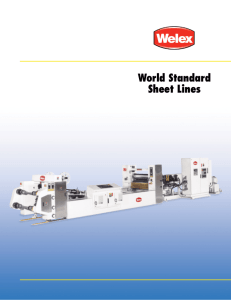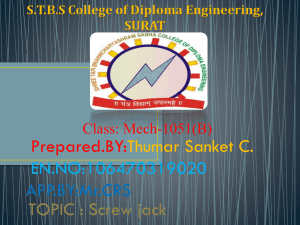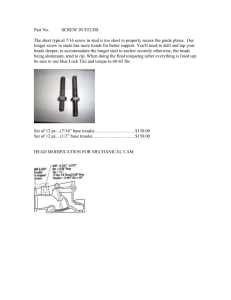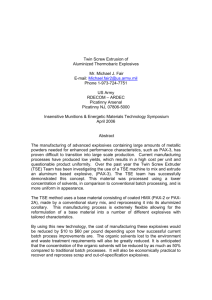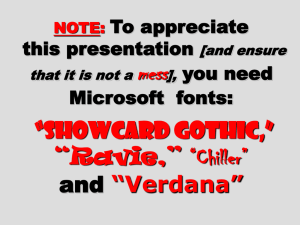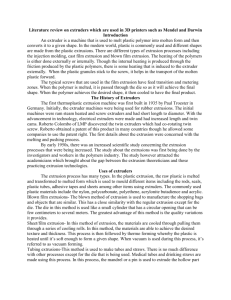Q .Exactly how does a twin screw extruder work ? A .It's simple
advertisement
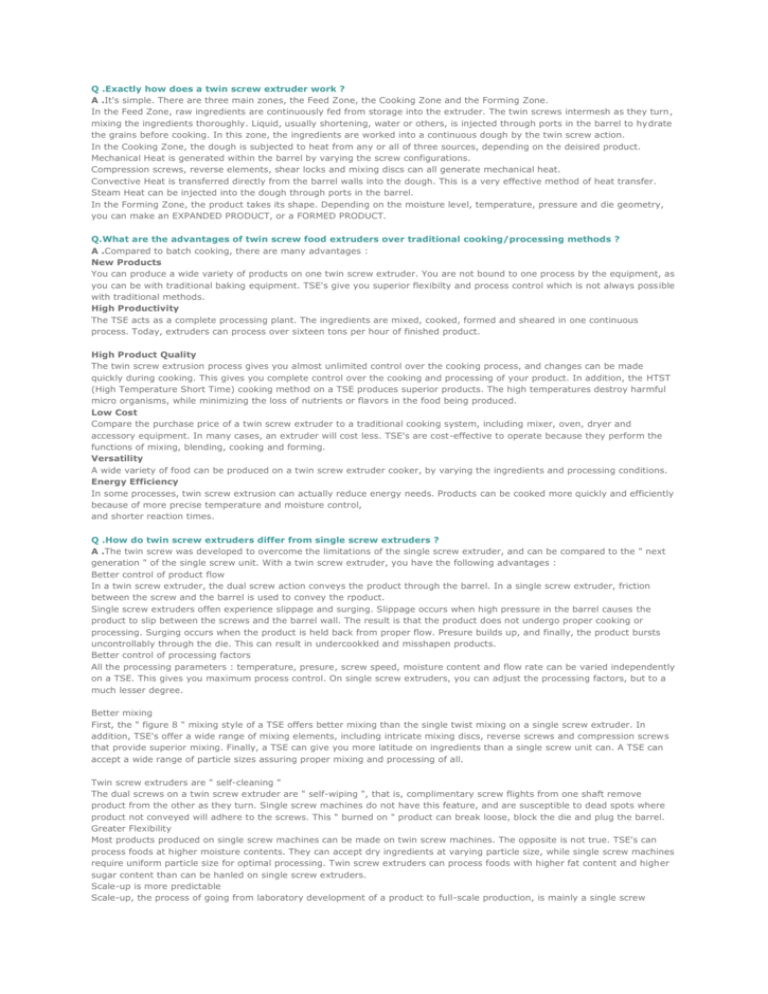
Q .Exactly how does a twin screw extruder work ? A .It's simple. There are three main zones, the Feed Zone, the Cooking Zone and the Forming Zone. In the Feed Zone, raw ingredients are continuously fed from storage into the extruder. The twin screws intermesh as they turn, mixing the ingredients thoroughly. Liquid, usually shortening, water or others, is injected through ports in the barrel to hydrate the grains before cooking. In this zone, the ingredients are worked into a continuous dough by the twin screw action. In the Cooking Zone, the dough is subjected to heat from any or all of three sources, depending on the deisired product. Mechanical Heat is generated within the barrel by varying the screw configurations. Compression screws, reverse elements, shear locks and mixing discs can all generate mechanical heat. Convective Heat is transferred directly from the barrel walls into the dough. This is a very effective method of heat transfer. Steam Heat can be injected into the dough through ports in the barrel. In the Forming Zone, the product takes its shape. Depending on the moisture level, temperature, pressure and die geometry, you can make an EXPANDED PRODUCT, or a FORMED PRODUCT. Q.What are the advantages of twin screw food extruders over traditional cooking/processing methods ? A .Compared to batch cooking, there are many advantages : New Products You can produce a wide variety of products on one twin screw extruder. You are not bound to one process by the equipment, as you can be with traditional baking equipment. TSE's give you superior flexibilty and process control which is not always possible with traditional methods. High Productivity The TSE acts as a complete processing plant. The ingredients are mixed, cooked, formed and sheared in one continuous process. Today, extruders can process over sixteen tons per hour of finished product. High Product Quality The twin screw extrusion process gives you almost unlimited control over the cooking process, and changes can be made quickly during cooking. This gives you complete control over the cooking and processing of your product. In addition, the HTST (High Temperature Short Time) cooking method on a TSE produces superior products. The high temperatures destroy harmful micro organisms, while minimizing the loss of nutrients or flavors in the food being produced. Low Cost Compare the purchase price of a twin screw extruder to a traditional cooking system, including mixer, oven, dryer and accessory equipment. In many cases, an extruder will cost less. TSE's are cost-effective to operate because they perform the functions of mixing, blending, cooking and forming. Versatility A wide variety of food can be produced on a twin screw extruder cooker, by varying the ingredients and processing conditions. Energy Efficiency In some processes, twin screw extrusion can actually reduce energy needs. Products can be cooked more quickly and efficiently because of more precise temperature and moisture control, and shorter reaction times. Q .How do twin screw extruders differ from single screw extruders ? A .The twin screw was developed to overcome the limitations of the single screw extruder, and can be compared to the " next generation " of the single screw unit. With a twin screw extruder, you have the following advantages : Better control of product flow In a twin screw extruder, the dual screw action conveys the product through the barrel. In a single screw extruder, friction between the screw and the barrel is used to convey the rpoduct. Single screw extruders offen experience slippage and surging. Slippage occurs when high pressure in the barrel causes the product to slip between the screws and the barrel wall. The result is that the product does not undergo proper cooking or processing. Surging occurs when the product is held back from proper flow. Presure builds up, and finally, the product bursts uncontrollably through the die. This can result in undercookked and misshapen products. Better control of processing factors All the processing parameters : temperature, presure, screw speed, moisture content and flow rate can be varied independently on a TSE. This gives you maximum process control. On single screw extruders, you can adjust the processing factors, but to a much lesser degree. Better mixing First, the " figure 8 " mixing style of a TSE offers better mixing than the single twist mixing on a single screw extruder. In addition, TSE's offer a wide range of mixing elements, including intricate mixing discs, reverse screws and compression screws that provide superior mixing. Finally, a TSE can give you more latitude on ingredients than a single screw unit can. A TSE can accept a wide range of particle sizes assuring proper mixing and processing of all. Twin screw extruders are " self-cleaning " The dual screws on a twin screw extruder are " self-wiping ", that is, complimentary screw flights from one shaft remove product from the other as they turn. Single screw machines do not have this feature, and are susceptible to dead spots where product not conveyed will adhere to the screws. This " burned on " product can break loose, block the die and plug the barrel. Greater Flexibility Most products produced on single screw machines can be made on twin screw machines. The opposite is not true. TSE's can process foods at higher moisture contents. They can accept dry ingredients at varying particle size, while single screw machines require uniform particle size for optimal processing. Twin screw extruders can process foods with higher fat content and higher sugar content than can be hanled on single screw extruders. Scale-up is more predictable Scale-up, the process of going from laboratory development of a product to full-scale production, is mainly a single screw problem. Scale-up on TSE's is not a problem as long as proper data is recorded during research and development of new products. Twin screw extrusion gives you very accurate control on production parameters, which is critical in scale-up. Reduced start-up and shut-down costs Start-up and shut-down can be handled more quickly on a twin screw extruder. This will save time and money, especially on high volume production lines. What is twin screw extrusion ? The twin screw extrusion process developed by Clextral over the past 50 years enables continuous production of homogenous compounds for the food industry, paper and plastics and chemical industries, using natural or synthetic raw materials. The active part of the machine consists of 2 identical corotating and intermeshing screws, hence the name "twin screw extruder". The screws are mounted on shafts, supported by bearings and rotate inside a fixed closed housing called "barrel". To adapt this equipment to different industrial applications, the screws, which perform most of the work of transporting, conveying, mixing, compressing, kneading or shearing of raw materials, have been designed to be totally modular. The screw segments are stacked one beside another on a splined shaft. Their composition can be rapidly modified depending on the products to be processed and the final product desired. Twin screw technology offers the advantages of a continuous process that is both flexible and easy to automate. The multifunctionality of this technology results in a compact design of the equipment, reduces the investment costs, often uses far less water and allows the use of greater diversity of raw materials. This continuous processing machine has multiple functions : conveying, melting, shearing, mixing, cooking, cooling, defibering, washing, bleaching, shaping... depending on the industrial application . 1. What is extrusion? Generally, extrusion is defined as a process of forcing material through a defined opening. For this to happen, the material must be either completely or partly in a fluid form so that it doesn’t block the opening when operating under reasonable pressure conditions. Examples of extruded foods include pastas, breakfast cereals, cookie dough, potato chips, baby food, dry pet food and ready-to-eat snacks. Examples of Fibre Polymer products are window and door frames, fibre polymer wood analogue panels, deck panels etc. 2. What are the advantages of food extrusion? • Continuous high throughput processing of foodstuffs. • Processing of relatively dry, viscous materials. • Improved textural and flavour characteristics of foods. • Control over the thermal changes of food constituents. • Use of unconventional ingredients. • Reduced effluents. • Enormous energy saving as a result of highly energy efficient processes. [ Top of Page ] 3. Why must manufacturers consider twin screw technology? Twin screw food extrusion cooking is the future. Today, extruders can be used for producing both human and animal foods, as well as industrial products. Manufacturers are discovering the many benefits of extrusion cooking over traditional methods, e.g. increased productivity, energy savings, reduced production costs, a minimal impact on the environment, clean process effluents. [ Top of Page ] 4. How do twin-screw extruders differ from single screw extruders? The twin-screw extruder (TSE) was developed to overcome the limitations of the single screw extruder. With the TSE you have the following advantages: • Twin-screw extruders (TSE) are 1.5 to 2.5 times more expensive to acquire. • TSE’s offers greater flexibility – it can handle a much wider variety of materials. • TSE’s have a uniform shear rate across the channel depth, a narrower residence time distribution, and better mixing and heat exchange capabilities. • TSE’s are easy to operate, control and are more flexible and less complex. • TSE’s are “self-cleaning”. • Reduced start-up and shut-down costs, which will save time and money especially on high volume production lines. • It is possible to achieve better product quality with a TSE. [ Top of Page ] 5. What are the advantages of twin screw extruders over traditional processing methods? Compared to traditional cooking methods, the advantages are: • New products: TSE’s give you flexibility and process control which is not always possible with traditional methods. • High productivity: The TSE acts as a complete processing plant. Extruders can produce over 16 tons per hour of finished product. • High product quality: It gives you an almost unlimited control over the cooking process and changes can be made quickly during the cooking process. • Low cost: TSEs are cost-effective to operate because they perform the functions of mixing, blending, cooking and forming. • Versatility: A wide variety of food can be produced on a TSE, by varying the ingredients and processing conditions. • Energy efficiency: In some processes, TSE can actually reduce energy needs. Products can be cooked more quickly and efficiently because of more precise temperature and moisture control, and shorter reaction times. [ Top of Page ] 6. Why invest in CFAM’s extruders? The following features make CFAM extruders ideally suited for the African continent: • It has been designed and manufactured in Africa for Africa. • It is competitively priced. • The extruders have been designed to be modular – a number of different products can be made on the same extruder. • The extruders are built and commissioned at the CFAM premises and tested thoroughly. The extruder is dispatched to the client’s site where it can be installed and commissioned within a day. • To ease the maintenance burden and cost most of the components can be purchased from local outlet shops. • CFAM can perform maintenance work on the extruders and consequently, plants will not be affected by breakdowns for long periods of time. [ Top of Page ] 7. What products are made on twin screw extruders? Extrusion can be used in for example the manufacture of snack products, breakfast cereals, heath bars, crisp breads, ice cream, confectionery and animal food. Plastic and wood composites can also be manufactured. The following is a comprehensive list of products: • Pet foods • Corn-Soy-Blends with cereals and legumes for the N or World Food Programme. • Infant food. • Extruded oilseeds into crude oil and partially defatted cakes/granules/flour. • Bioreactor or bio-extrude with enzymes to obtain high density grain products. • Extruded, floating or suspended pellets for fish. • Wood/plastic composite products/structures. • Extruded composite cereals from e.g. wheat, sorghum, cassava, barley, rice, peanuts, millets, peas, beans, sweet potatoes, green bananas, plantain. • Third generation (3G) extrudates or high density, expandable, snack pellets to be puffed in hot oil or a microwave oven, like “nik naks”. • Texturised Vegetable Protein (TVP) for instance soy-mince. • Extruded pasta noodles from composite cereal flours. • Protein-enriched snacks and breakfast cereal flakes (extruded/rolled, toasted). • Extruded cereal-substrates for ethanol fermentation and extruded ethanol-by-products. • Intermediate-extruded, meat analogues. • High-moisture extrusion cooking (HMEC) or restructured/processed, whole-muscle meat alternatives or textured, vegetarian soy-based meat analogues. • Starch-based, low-density, direct-expanded foams as packing material/fillers. • Bio-degradable (edible) extruded starch plus polymers as packaging films. • Extrusion cooking of breading to coat nuggets of chicken, fish, cutlets etc. • Co-extrusion of multi-layered, multi component snacks simultaneously. [ Top of Page ] 8. What are the components of a typical twin-screw extruder? The main components are: • The screws; • The barrel; • The drive motor with speed control; • The gearing mechanism; • The die; and • The product cutter. [ Top of Page ] 9. How does a twin screw extruder operate? There are three areas: the Feed Area, the Cooking Area and the Forming Area. In the Feed Area, raw ingredients are continuously fed from storage into the extruder. The twin screws intermesh as they turn, mixing the ingredients. Liquid, usually shortening, water or others, is injected through ports in the barrel to hydrate the grains before cooking. The ingredients are worked into a continuous dough by the screw action. In the Cooking Area, the dough is subjected to heat from one or all sources of heat i.e. mechanical heat, convective heat or steam heat. In the Forming Area, the product is given a shape. Depending on the moisture level, temperature, pressure and the geometry, an expanded or formed product can be obtained. [ Top of Page ] 10. What is the difference between an expanded product and a formed product? Expanded products To manufacture expanded products, the pressure and temperature are increased, while the moisture level is accurately controlled. When the product exerts the extruder through the forming die, the change in atmospheric pressure causes the internal moisture to turn to steam. This puffs he fully-cooked dough into an expanded product. Formed product To create formed or pelletized products, a high moisture dough is used at a lower temperature. When the extrudate is forced through the forming die, the product takes the shape of the die, instead of expanding. The result is a dense intricately-shaped pellet.

